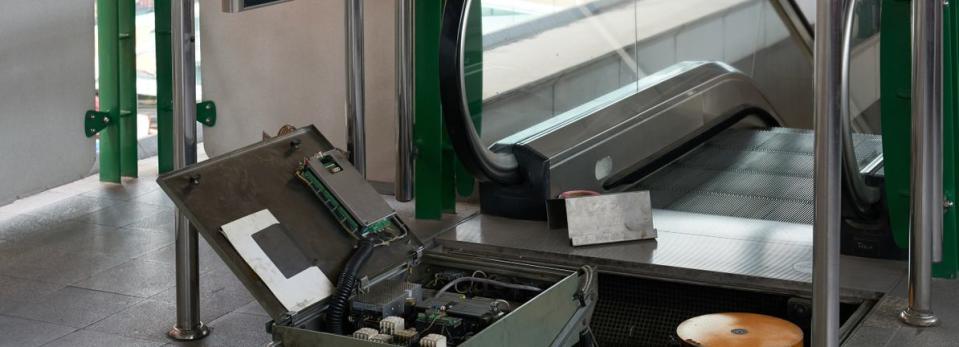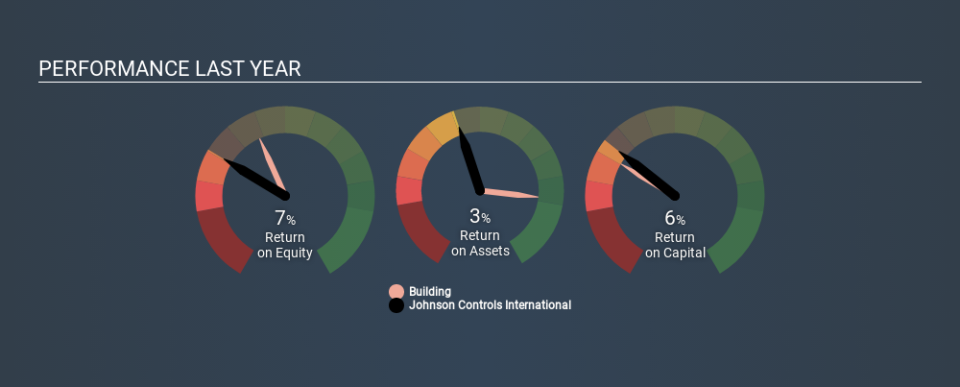Why Johnson Controls International plc’s (NYSE:JCI) Return On Capital Employed Looks Uninspiring

Today we'll look at Johnson Controls International plc (NYSE:JCI) and reflect on its potential as an investment. To be precise, we'll consider its Return On Capital Employed (ROCE), as that will inform our view of the quality of the business.
First up, we'll look at what ROCE is and how we calculate it. Second, we'll look at its ROCE compared to similar companies. Then we'll determine how its current liabilities are affecting its ROCE.
What is Return On Capital Employed (ROCE)?
ROCE is a metric for evaluating how much pre-tax income (in percentage terms) a company earns on the capital invested in its business. All else being equal, a better business will have a higher ROCE. In brief, it is a useful tool, but it is not without drawbacks. Author Edwin Whiting says to be careful when comparing the ROCE of different businesses, since 'No two businesses are exactly alike.
How Do You Calculate Return On Capital Employed?
Analysts use this formula to calculate return on capital employed:
Return on Capital Employed = Earnings Before Interest and Tax (EBIT) ÷ (Total Assets - Current Liabilities)
Or for Johnson Controls International:
0.058 = US$1.9b ÷ (US$43b - US$9.7b) (Based on the trailing twelve months to December 2019.)
Therefore, Johnson Controls International has an ROCE of 5.8%.
Check out our latest analysis for Johnson Controls International
Does Johnson Controls International Have A Good ROCE?
When making comparisons between similar businesses, investors may find ROCE useful. In this analysis, Johnson Controls International's ROCE appears meaningfully below the 13% average reported by the Building industry. This performance could be negative if sustained, as it suggests the business may underperform its industry. Aside from the industry comparison, Johnson Controls International's ROCE is mediocre in absolute terms, considering the risk of investing in stocks versus the safety of a bank account. It is possible that there are more rewarding investments out there.
You can click on the image below to see (in greater detail) how Johnson Controls International's past growth compares to other companies.
When considering this metric, keep in mind that it is backwards looking, and not necessarily predictive. ROCE can be misleading for companies in cyclical industries, with returns looking impressive during the boom times, but very weak during the busts. This is because ROCE only looks at one year, instead of considering returns across a whole cycle. Since the future is so important for investors, you should check out our free report on analyst forecasts for Johnson Controls International.
What Are Current Liabilities, And How Do They Affect Johnson Controls International's ROCE?
Current liabilities are short term bills and invoices that need to be paid in 12 months or less. Due to the way the ROCE equation works, having large bills due in the near term can make it look as though a company has less capital employed, and thus a higher ROCE than usual. To counteract this, we check if a company has high current liabilities, relative to its total assets.
Johnson Controls International has current liabilities of US$9.7b and total assets of US$43b. Therefore its current liabilities are equivalent to approximately 23% of its total assets. It is good to see a restrained amount of current liabilities, as this limits the effect on ROCE.
What We Can Learn From Johnson Controls International's ROCE
If Johnson Controls International continues to earn an uninspiring ROCE, there may be better places to invest. You might be able to find a better investment than Johnson Controls International. If you want a selection of possible winners, check out this free list of interesting companies that trade on a P/E below 20 (but have proven they can grow earnings).
For those who like to find winning investments this free list of growing companies with recent insider purchasing, could be just the ticket.
If you spot an error that warrants correction, please contact the editor at editorial-team@simplywallst.com. This article by Simply Wall St is general in nature. It does not constitute a recommendation to buy or sell any stock, and does not take account of your objectives, or your financial situation. Simply Wall St has no position in the stocks mentioned.
We aim to bring you long-term focused research analysis driven by fundamental data. Note that our analysis may not factor in the latest price-sensitive company announcements or qualitative material. Thank you for reading.

 Yahoo Finance
Yahoo Finance 
